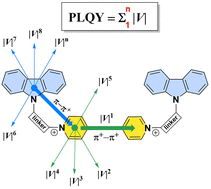Leduskrasts, K.; Kinens, A.; Suna, E.; Chem. Commun. 2023, 59, 6905 – 6908. Download publication. DOI: 10.1039/d3cc01674a
Abstract
Cationic luminophores have recently emerged as a class of efficient emitters in both the solid state and solutions. However, the underlying processes that secure the emission in these luminophores are poorly understood. Here, we employ charge transfer integral (CTI) analysis in combination with X-ray single crystal data to uncover the emission mechanism in a series of pyridinium luminophores. We demonstrate that the solid state photoluminescence quantum yield (Φ) of cationic luminophores is directly proportional to the charge transfer (CT) intensity within a network of molecules in the crystal lattice. Electrostatic intermolecular interactions between π+-systems in the crystal lattice provide a disproportionately high contribution to the CT intensity and therefore are instrumental in achieving high Φ. In addition, the strength of electrostatic interactions can be increased by a through-space (TS) electron-donation strategy. Hence, electrostatic interactions can be utilized as a tool to achieve radiative CT, which is useful in the development of efficient luminophores, sensors and nonlinear optical materials.

